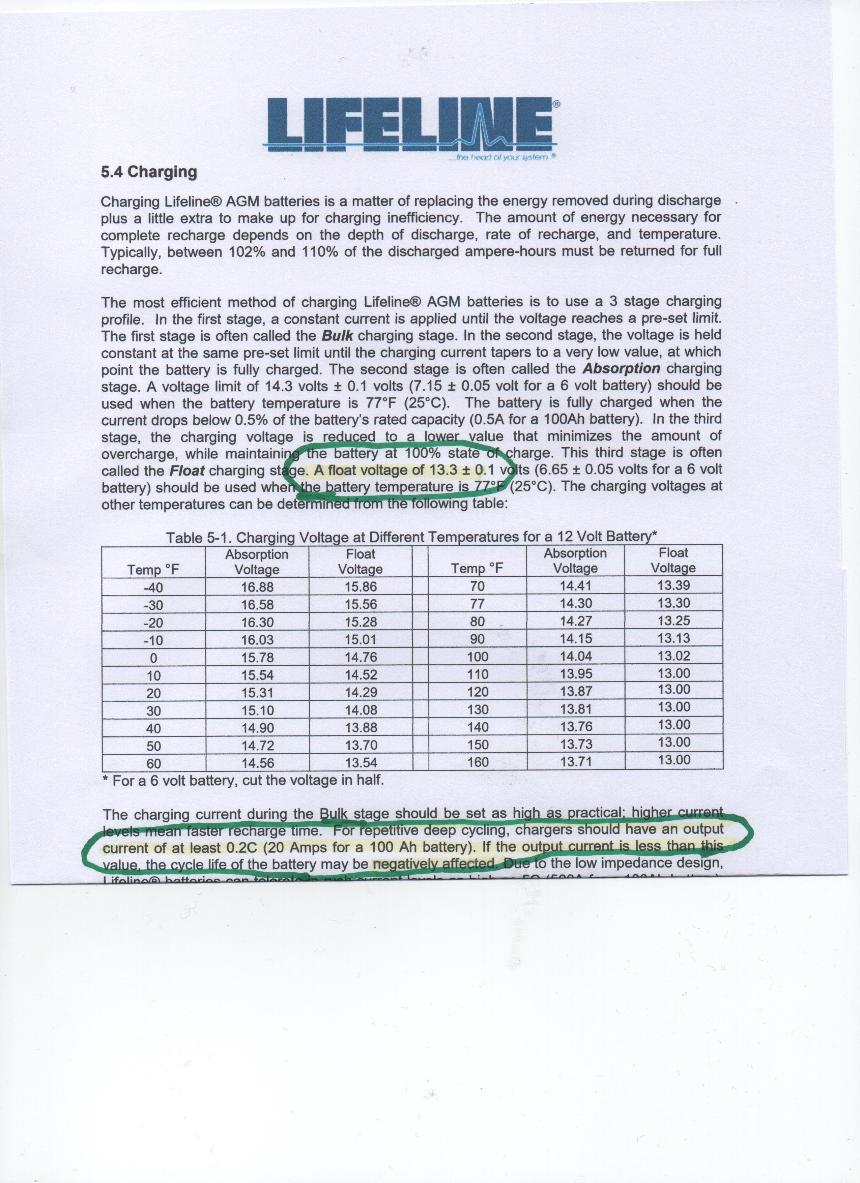It is rated at a poor 70 cycles yet costs £99.
Versus the best in the Class, the Varta LFD90 : https://www.alpha-batteries.co.uk/12v-90ah-varta-lfd-90-professional-leisure-battery-930090080/
It is rated at a very good 200+ cycles at £105
The Alpha Batteries web pages show how easy it is to compare batteries, the only one we know that lists the number of cycles for a battery.
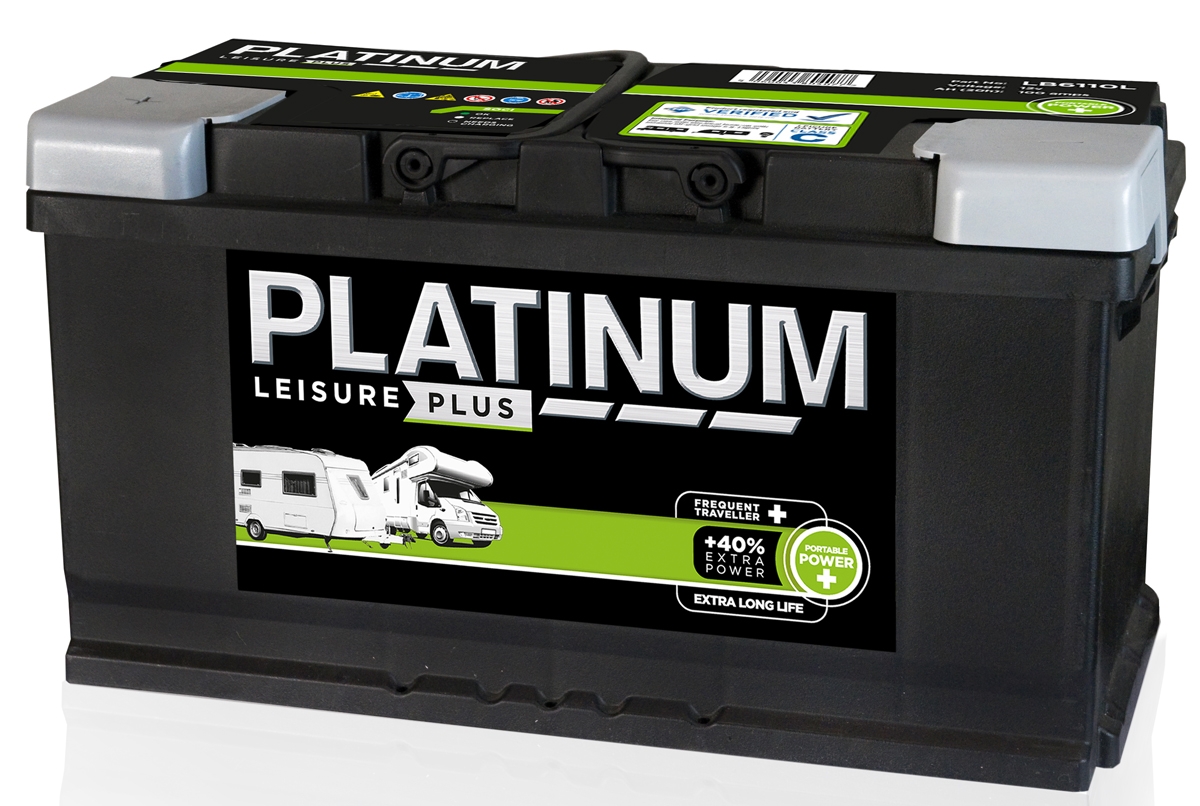
The model name of LB6110L is also designed to deliberately deceive that this could be a 110Ah battery, not the 100Ah it is allegedly rated as.
"4.1.4 Model numbers that can be confused with capacity, i.e. 12V110, shall not be used".
For the first time EVER, the CAMC publishes advice to actually avoid AGM batteries in line with our campaign. See further down these pages, for our reasons why AGM batteries don't work in motorhomes.
The CAMC article states something like :-
"In general, it's probably best to avoid AGM batteries unless you are absolutely sure your charger is suitable, as the otherwise excellent performance counts for little if the performance is compromised through damage by inappropriate charging".
That warning has never before been published by a Magazine or Club.
We consider that a huge breakthrough in helping to stop people from being disadvantaged by unsuitable battery sales that end up costing the buyer twice as much with half the life.
Hopefully things will now change and the NCC Verified scheme front page will also start warning people that AGM batteries should only be used if the Alternator output voltage (most are too low) and the mains charger is optimised for AGM with a specific AGM/Gel/Wet profile switch?
I will take that as another success for our efforts.
You state that "Battery verification comes via a comprehensive, industry-leading, testing process conducted by suitably certified and audited test houses”.
Kind regards
James Brown BEM

|
NCC Verified Battery Scheme v5.0 A and N Caravan.pdf Size : 1281.21 Kb Type : pdf |
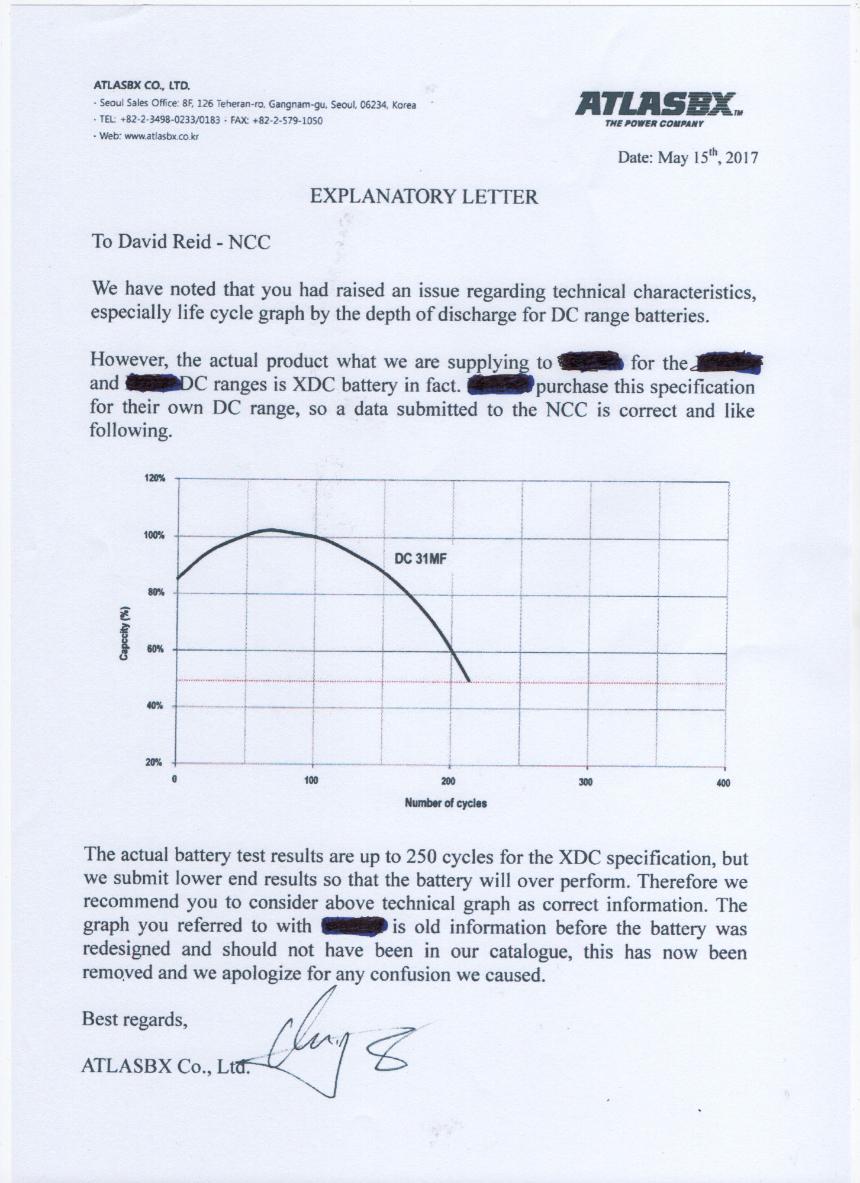
If you apply the rules of BS EN 50342, the graph shows the battery is exhausted at 160 cycles, but the Korean Battery company go on counting the cycles right down to 50% capacity. Obviously that breaches the BS EN 50342 guidelines but shows how some companies count the cycles the Top battery manufacturers think are worthless to the consumer.
So while the letter actually contains a graph that proves the battery should be rated at a maximum 160 cycles, the NCC have listed it as 220 cycles.
You may ask why did the NCC need a letter in the first place if the NCC have all the test data?
If you look at the last few paragraphs you will find the answer. The letter is being written in response to questions on the content of the AtlasBx Sales Catalogue, it states -
"The graph you referred to with DCxx is old information before the battery was redesigned and should not have been in our catalogue"
You may also ask why was the NCC looking at the 'Sales Catalogue' in the first place and using it to query a batteries Tech. Spec, if it had all the laboratory BS EN 50342 test data?
The battery has been listed in the NCC 'verified' scheme as having 220 cycles, so clearly this letter has been used to 'verify' the battery.
The battery we tested didn't reach 80 cycles, a huge variance from the NCC 'Verified' 220 cycle rating.
The Graph below from the Battery manufacturers catalogue shows the DC range ONLY achieves around 80 cycles at 50% Depth of Discharge (DOD) matching our test figure.
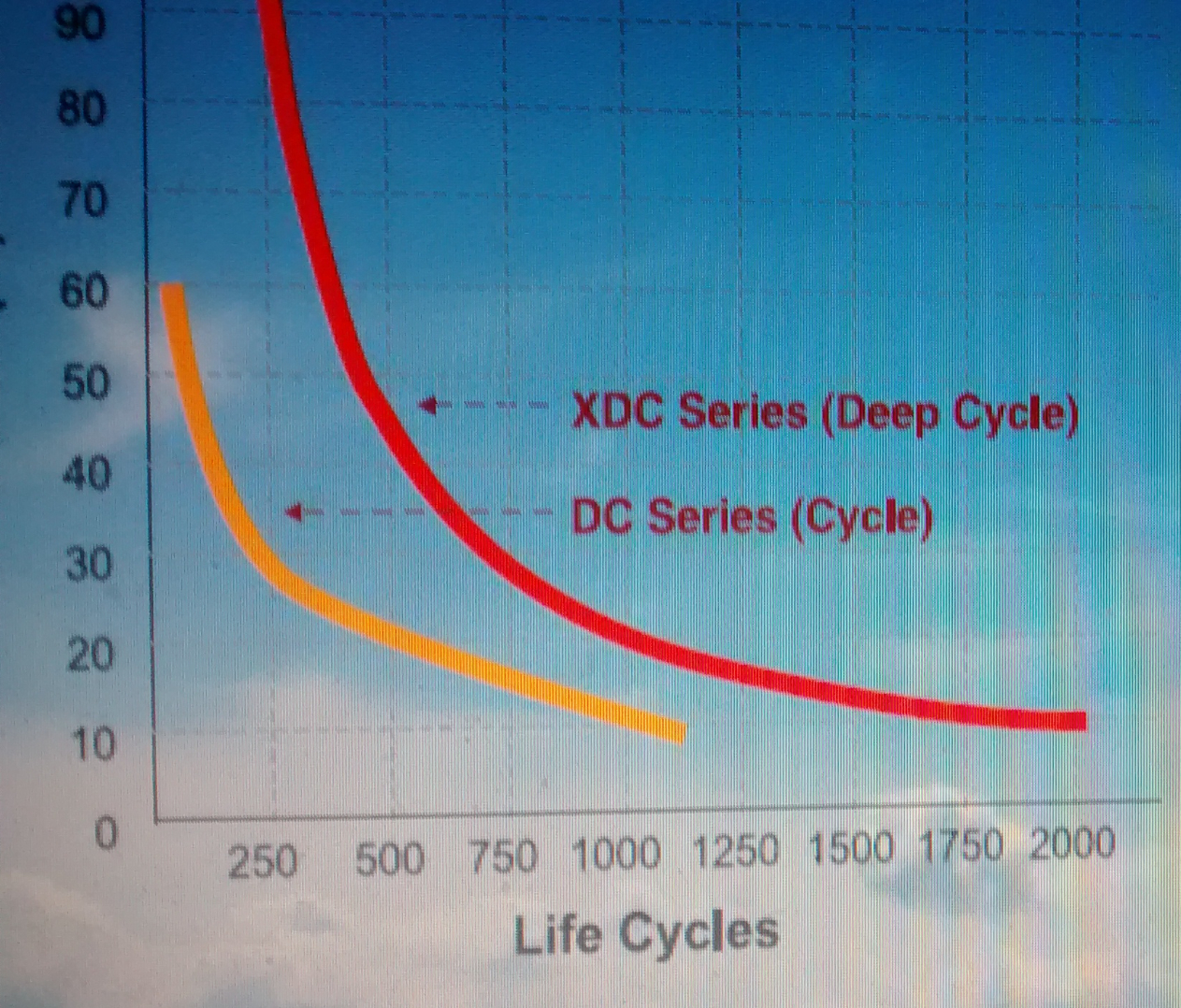
That is clear evidence that the NCC portray the scheme very differently to the way it actually operates. The skills of the operators of the scheme, from it's setting up, description, aims, verification, etc all show a serious lack of battery knowledge and honesty.
More worrying is that the Asian Battery manufacturers are testing to a completely different standard to that of the UK and ending up with far more cycles than the BE EN 50342 standards says should be counted.
No wonder the Asian batteries, on paper, seem to outperform the likes of Banner, Varta, Exide, etc.
But Worse Than False Figures.
All the above questions what the NCC scheme is trying to be and the integrity of the data, but the third, most serious issue in my book, is that the NCC scheme is actively promoting AGM batteries that are unsuitable for the application the scheme claims they are 'Verified' for.
Alpha Batteries are the first retailer we have seen that now posts a prominent warning on their web pages about AGM batteries :-
"Please ensure your charging method can accommodate AGM batteries as charging at non AGM charge settings can adversely affect the life of the battery".
Well done Alpha Batteries.
A champion retailer - that is putting the consumer before profit.
All big battery manufacturers state that their AGM battery must be charged with AGM optimised charging systems.
Banner Batteries have an FAQ on their website with a question on charging AGM : batterieshttps://www.bannerbatterien.com/en-gb/Support/FAQ.
Not only does it stipulate a higher 14.8v 'Boost' charge rate, but the Float rate should be an ultra low 13.5v, which is exceptionally rare on ANY Caravan/Motorhome multi stage charger, let alone an AGM specific version.
The FAQ states :-
"What values should I use when setting an external charger for AGM batteries in the caravan? How high should the charging and float charge voltage be?"
"Please employ the AGM setting, which means that the charge voltage should be set at max. 14.8V and the float charge voltage at 13.5V. Best of all, use an IUoU characteristic with temperature compensation".
See the full document near the bottom of this page.
Note that it additionally suggests temperature compensation on the charger, something most AGM battery manufactures recommend.
We would estimate less than 1% of Caravans/Motorhomes would have one of these. Some of the Sargent units have temperature sensing of the battery compartment, but not the battery plate temperature which generally uses a sensor on the battery clamp.
If you look at the Concorde Lifeline battery table at the bottom of the page, you will see that their AGM batteries must not be maintenance/Float charged at higher than 13.3v at 21.1 degrees C/70 degrees Fah. or 13.1v at 32 degrees C/90 Fah. Compared to those very low voltages, a Motorhomes typical mains 13.8v charger in Spain in Summer is going to do reduce an AGM's life by a massive margin.
We are not aware of any Motorhome/Caravan mains charger with 14.8v/13.4v mains charger and temperature compensation that has EVER been fitted to a mainstream Leisure vehicle up to early 2019.
Few professional fit Solar Charger/Regulators have effective temperature compensation or charge profiles that follow the above guidelines.
The battery manufacturers say that failure to charge an AGM exactly as the manufacturers spec, results in premature failure, often less than 2 years, typically 18 months.
It makes me wonder if the promotion of AGM's by the NCC is a deliberate ploy to fatten the bank accounts of the companies who make payments to the NCC to have their batteries 'verified'?
The sale of double the cost batteries with half the life of a budget battery delivers a big enough financial incentive to not be honest.
We were highlighting premature AGM Motorhome battery failures in 2014, some that didn't last 18 months. See here for more info on the limitations of AGM batteries.
The Battery Industries perception that Caravans and Motorhomes contain sophisticated chargers is wrong, they are often crude Power Supply/Chargers. Most don't even charge the habitation battery above 13.9v from the Alternator/Engine.
For anyone who mistrusts our claim that 99% of British motorhomes don't have AGM optimised chargers, then read the "A bit of History on the Leisure battery chargers installed in Caravan and Motorhomes" section towards the bottom of the AGM Battery web page.
We want the industry to work towards clearer battery labelling.
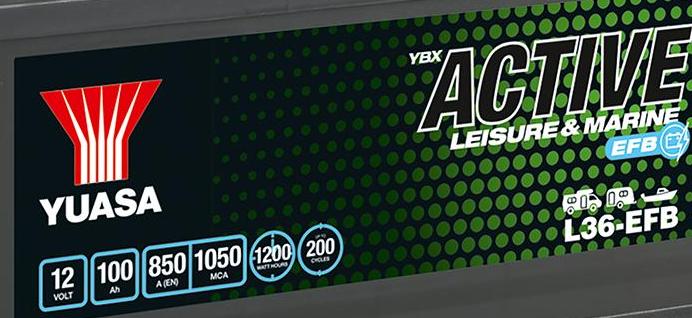
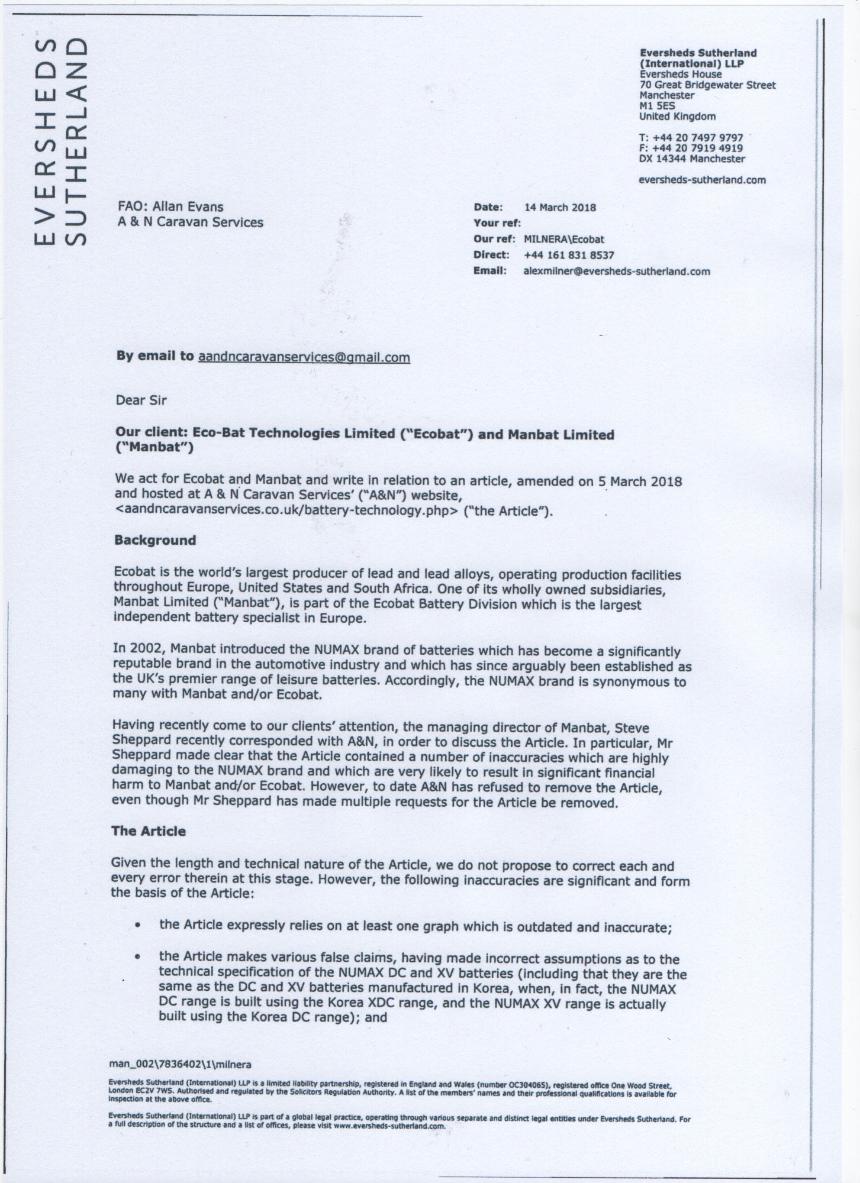

|
Banner Batteries FAQs Dowloaded August 2018.pdf Size : 206.577 Kb Type : pdf |
